Motion User Guide
- Welcome
- What’s new
-
- Intro to basic compositing
-
- Intro to transforming layers
-
- Intro to transforming layers in the canvas
- Transform layer properties in the canvas
- Transform tools
- Change layer position, scale, or rotation
- Move a layer’s anchor point
- Add a drop shadow to a layer
- Distort or shear a layer
- Crop a layer
- Modify shape or mask points
- Transform text glyphs and other object attributes
- Align layers in the canvas
- Transform layers in the HUD
- Transform 2D layers in 3D space
-
- Intro to behaviors
- Behaviors versus keyframes
-
- Intro to behavior types
-
- Intro to Parameter behaviors
- Audio behavior
- Average behavior
- Clamp behavior
- Custom behavior
- Add a Custom behavior
- Exponential behavior
- Link behavior
- Logarithmic behavior
- MIDI behavior
- Add a MIDI behavior
- Negate behavior
- Oscillate behavior
- Create a decaying oscillation
- Overshoot behavior
- Quantize behavior
- Ramp behavior
- Randomize behavior
- Rate behavior
- Reverse behavior
- Stop behavior
- Track behavior
- Wriggle behavior
-
- Intro to Simulation behaviors
- Align to Motion behavior
- Attracted To behavior
- Attractor behavior
- Drag behavior
- Drift Attracted To behavior
- Drift Attractor behavior
- Edge Collision behavior
- Gravity behavior
- Orbit Around behavior
- Random Motion behavior
- Repel behavior
- Repel From behavior
- Rotational Drag behavior
- Spring behavior
- Vortex behavior
- Wind behavior
- Additional behaviors
-
- Intro to using generators
- Add a generator
-
- Intro to image generators
- Caustics generator
- Cellular generator
- Checkerboard generator
- Clouds generator
- Color Solid generator
- Concentric Polka Dots generator
- Concentric Shapes generator
- Gradient generator
- Grid generator
- Japanese Pattern generator
- Lens Flare generator
- Manga Lines generator
- Membrane generator
- Noise generator
- One Color Ray generator
- Op Art 1 generator
- Op Art 2 generator
- Op Art 3 generator
- Overlapping Circles generator
- Radial Bars generator
- Soft Gradient generator
- Spirals generator
- Spiral Drawing generator
- Use Spiral Drawing onscreen controls
- Star generator
- Stripes generator
- Sunburst generator
- Truchet Tiles generator
- Two Color Ray generator
- Save a modified generator
-
- Intro to filters
- Browse and preview filters
- Apply or remove filters
-
- Intro to filter types
-
- Intro to Color filters
- Brightness filter
- Channel Mixer filter
- Color Balance filter
- Example: Color-balance two layers
- Color Curves filter
- Use the Color Curves filter
- Color Reduce filter
- Color Wheels filter
- Use the Color Wheels filter
- Colorize filter
- Contrast filter
- Custom LUT filter
- Use the Custom LUT filter
- Gamma filter
- Gradient Colorize filter
- HDR Tools filter
- Hue/Saturation filter
- Hue/Saturation Curves filter
- Use the Hue/Saturation Curves filter
- Levels filter
- Negative filter
- OpenEXR Tone Map filter
- Sepia filter
- Threshold filter
- Tint filter
-
- Intro to Distortion filters
- Black Hole filter
- Bulge filter
- Bump Map filter
- Disc Warp filter
- Droplet filter
- Earthquake filter
- Fisheye filter
- Flop filter
- Fun House filter
- Glass Block filter
- Glass Distortion
- Insect Eye filter
- Mirror filter
- Page Curl filter
- Poke filter
- Polar filter
- Refraction filter
- Ring Lens filter
- Ripple filter
- Scrape filter
- Sphere filter
- Starburst filter
- Stripes filter
- Target filter
- Tiny Planet filter
- Twirl filter
- Underwater filter
- Wave filter
-
- Intro to Stylize filters
- Add Noise filter
- Bad Film filter
- Bad TV filter
- Circle Screen filter
- Circles filter
- Color Emboss filter
- Comic filter
- Crystallize filter
- Edges filter
- Extrude filter
- Fill filter
- Halftone filter
- Hatched Screen filter
- Highpass filter
- Indent filter
- Line Art filter
- Line Screen filter
- MinMax filter
- Noise Dissolve filter
- Pixellate filter
- Posterize filter
- Relief filter
- Slit Scan filter
- Slit Tunnel filter
- Texture Screen filter
- Vignette filter
- Wavy Screen filter
- Publish filter parameters to Final Cut Pro
- Using filters on alpha channels
- Filter performance
- Save custom filters
-
- Intro to 360-degree video
- 360-degree projects
- Create 360-degree projects
- Add 360-degree video to a project
- Create a tiny planet effect
- Reorient 360-degree media
- Creating 360-degree templates for Final Cut Pro
- 360-degree-aware filters and generators
- Export and share 360-degree projects
- Guidelines for better 360-degree projects
-
- Intro to tracking
- How does motion tracking work?
- Motion tracking behavior types
- Analyze motion in a clip
- Stabilize a shaky clip
- Unstabilize a clip
- Use a range of frames for analysis
- Load existing tracking data
- Track shapes, masks, and paint strokes
- Track a filter’s position parameter
- Adjust onscreen trackers
- Save tracks to the Library
-
- Intro to preferences and shortcuts
-
- Intro to Keyboard shortcuts
- Use function keys
- General keyboard shortcuts
- Audio list keyboard shortcuts
-
- Tools keyboard shortcuts
- Transform tool keyboard shortcuts
- Select/Transform tool keyboard shortcuts
- Crop tool keyboard shortcuts
- Edit Points tool keyboard shortcuts
- Edit shape tools keyboard shortcuts
- Pan and Zoom tools keyboard shortcuts
- Shape tools keyboard shortcuts
- Bezier tool keyboard shortcuts
- B-Spline tool keyboard shortcuts
- Paint Stroke tool keyboard shortcuts
- Text tool keyboard shortcuts
- Shape mask tools keyboard shortcuts
- Bezier Mask tool keyboard shortcuts
- B-Spline Mask tool keyboard shortcuts
- Transport control keyboard shortcuts
- View option keyboard shortcuts
- HUD keyboard shortcuts
- Inspector keyboard shortcuts
- Keyframe Editor keyboard shortcuts
- Layers keyboard shortcuts
- Library keyboard shortcuts
- Media list keyboard shortcuts
- Timeline keyboard shortcuts
- Keyframing keyboard shortcuts
- Shape and Mask keyboard shortcuts
- 3D keyboard shortcuts
- Miscellaneous keyboard shortcuts
- Touch Bar shortcuts
- Move assets to another computer
- Work with GPUs
- Copyright

Create and manage snapshots in Motion
You can record and modify snapshots using the controls in the Rig Inspector or Widget Inspector.
Record a snapshot
In Motion, select a rig or widget in the Layers list.
For information about creating rigs and widgets, see Build a simple rig in Motion.
In the Rig Inspector or Widget Inspector, choose a snapshot state from the widget control you want to record to:
Slider widget: Select a snapshot tag (one of the gray shaded circles under the slider) to record to. To create a new snapshot tag, double-click an empty area below the slider. When selected, the snapshot tag is highlighted blue.
Pop-up menu widget: Click the pop-up menu, then choose an item (Snapshot 1, Snapshot 2, or Snapshot 3) to record to.
Checkbox widget: To record to the selected state, select the checkbox. To record to the deselected state, deselect the checkbox.
Click the Edit Mode Start button under the widget control you prepared in step 2.
A window appears containing a Stop Rig Edit Mode button. The appearance of this window indicates that changes you make to parameters will be recorded.
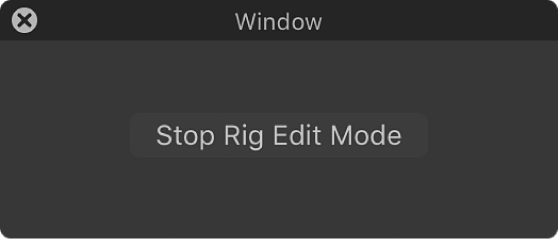
Make changes to one or more parameters of one or more objects in your project using the onscreen controls in the canvas or the numeric controls in the HUD or Inspector.
Each adjustment you make is recorded to the snapshot setting selected in the widget (the checkbox, pop-up menu item, or slider position).
After you set the parameters to the desired snapshot state, click the Stop Rig Edit Mode button.
Recording is stopped, and the snapshot is stored to the widget. Modified parameters are added to the Rig Inspector and Widget Inspector (under the Edit Mode Start button) alongside a joystick icon indicating that the parameter is rigged.
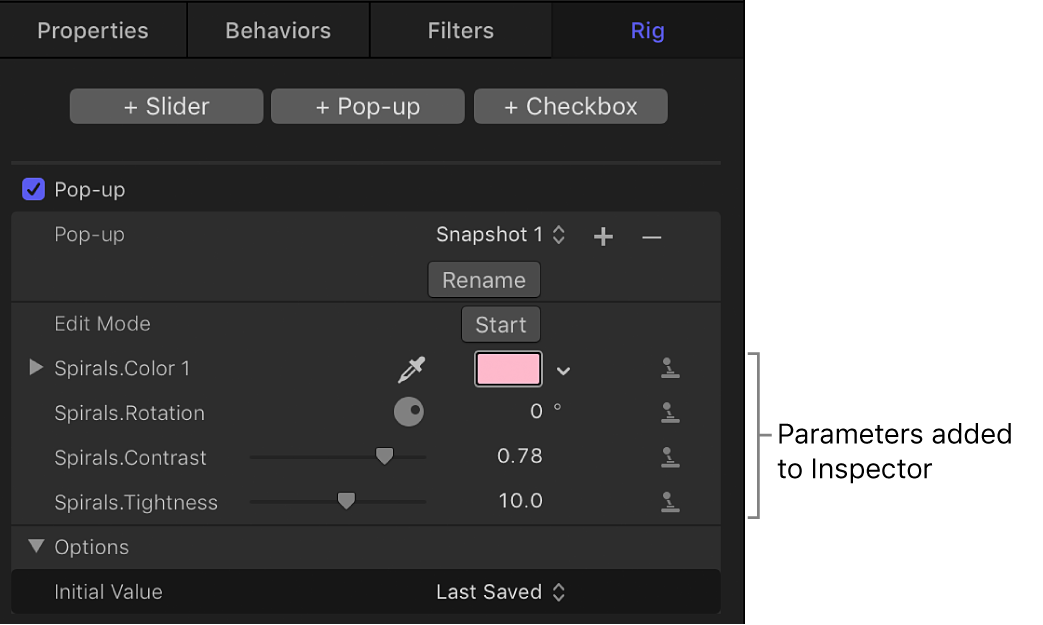
To set additional snapshots, choose an unassigned snapshot in the widget, then adjust the parameters. To add more parameters, repeat steps 2–5.
Add a snapshot tag to a slider widget
By default there are two recordable snapshot settings in a slider widget, represented by snapshot tags: shaded gray circles under the slider, and at either end. When you record snapshots to these two tags, values along the slider between the two tags are interpolated; in other words, when you drag the slider, the affected parameters change gradually, ramping between the values of adjacent snapshots.
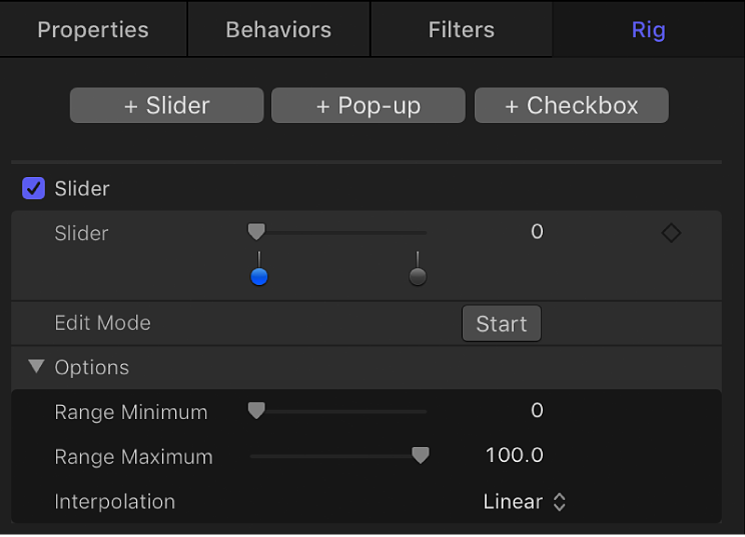
You can add additional snapshot tags to the slider widget to create more complex ranges of parameter change.
In Motion, select a rig or widget in the Layers list.
For information about creating rigs and widgets, see Build a simple rig in Motion.
In the Rig Inspector or Widget Inspector, double-click an empty area below a slider widget.
A new snapshot tag appears under the slider. Parameters at this position inherit their values based on the interpolation point between the two snapshot tags adjacent to the new snapshot tags. You can reorder snapshot tags by dragging them left or right under the slider.
To record new or additional parameter values for a snapshot tag, see “Record a snapshot” above.
Change the value of a snapshot tag
You can quickly change the value of a snapshot tag without entering Rig Edit Mode.
Do one of the following:
Click a slider widget tag, then enter a number in the value slider.
Double-click a slider widget tag, then enter a number in the value field.
Delete a snapshot tag from a slider widget
In Motion, drag the tag away from the area under the slider.
Rename a snapshot in a pop-up menu widget
By default the snapshot settings in a pop-up menu widget are named Snapshot 1, Snapshot 2, and Snapshot 3. You can give them more descriptive names using the Rename button.
Select a rig or widget in the Layers list in Motion.
For information about creating rigs and widgets, see Build a simple rig in Motion.
In the Rig Inspector or Widget Inspector, choose an item from the pop-up menu (Snapshot 1, Snapshot 2, or Snapshot 3), then click the Rename button.
Enter a new name in the highlighted field, then press Return.
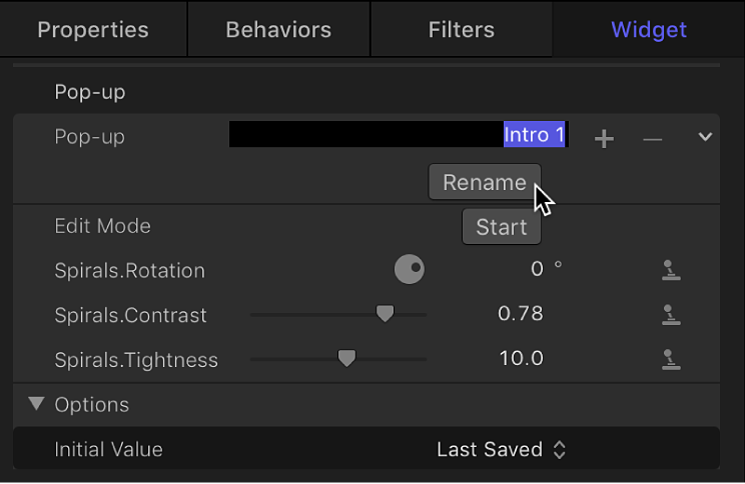
The menu item updates to the new name.
Repeat steps 2 and 3 to rename additional pop-up menu items.
Add snapshot items to a pop-up menu widget
By default, the pop-up menu widget contains three menu items (Snapshot 1, Snapshot 2, and Snapshot 3). You can add or remove menu items using the Add or Delete button.
Select a rig or widget in the Layers list in Motion.
For information about creating rigs and widgets, see Build a simple rig in Motion.
In the Rig Inspector or Widget Inspector, choose an item from the pop-up menu, then do one of the following:
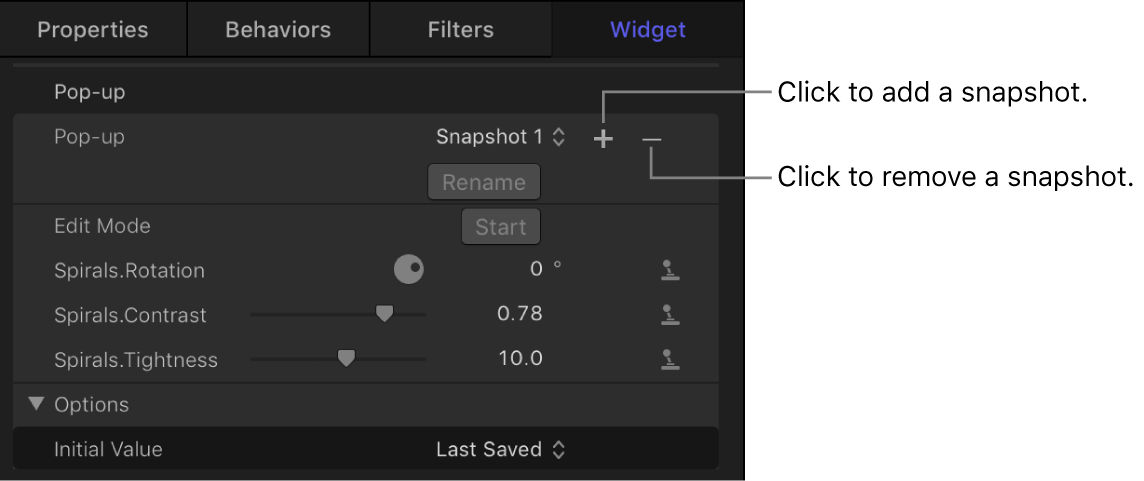
Add a menu item: Click the Add button (+) to the right of the pop-up menu, enter a name for the new item in the highlighted field, then press Return.
New snapshots are added below the currently selected snapshot.
Remove a menu item: Click the Delete button (–) to the right of the pop-up menu.